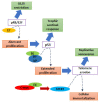Epidemiology, Molecular Pathogenesis, Immuno-Pathogenesis, Immune Escape Mechanisms and Vaccine Evaluation for HPV-Associated Carcinogenesis
- PMID: 38133265
- PMCID: PMC10745624
- DOI: 10.3390/pathogens12121380
Epidemiology, Molecular Pathogenesis, Immuno-Pathogenesis, Immune Escape Mechanisms and Vaccine Evaluation for HPV-Associated Carcinogenesis
Abstract
Human papillomavirus (HPV) is implicated in over 90% of cervical cancer cases, with factors like regional variability, HPV genotype, the population studied, HPV vaccination status, and anatomical sample collection location influencing the prevalence and pathology of HPV-induced cancer. HPV-16 and -18 are mainly responsible for the progression of several cancers, including cervix, anus, vagina, penis, vulva, and oropharynx. The oncogenic ability of HPV is not only sufficient for the progression of malignancy, but also for other tumor-generating steps required for the production of invasive cancer, such as coinfection with other viruses, lifestyle factors such as high parity, smoking, tobacco chewing, use of contraceptives for a long time, and immune responses such as stimulation of chronic stromal inflammation and immune deviation in the tumor microenvironment. Viral evasion from immunosurveillance also supports viral persistence, and virus-like particle-based prophylactic vaccines have been licensed, which are effective against high-risk HPV types. In addition, vaccination awareness programs and preventive strategies could help reduce the rate and incidence of HPV infection. In this review, we emphasize HPV infection and its role in cancer progression, molecular and immunopathogenesis, host immune response, immune evasion by HPV, vaccination, and preventive schemes battling HPV infection and HPV-related cancers.
Keywords: HPV-associated carcinogenesis; HPV-infection; immune evasion; immuno-pathogenesis; vaccination.
Conflict of interest statement
The authors have no conflicts of interest.
Figures




Similar articles
-
Recent Developments in Human Papillomavirus (HPV) Vaccinology.Viruses. 2023 Jun 26;15(7):1440. doi: 10.3390/v15071440. Viruses. 2023. PMID: 37515128 Free PMC article. Review.
-
Immunopathogenesis of HPV-Associated Cancers and Prospects for Immunotherapy.Viruses. 2017 Sep 12;9(9):254. doi: 10.3390/v9090254. Viruses. 2017. PMID: 28895886 Free PMC article. Review.
-
Long-term incidence trends of HPV-related cancers, and cases preventable by HPV vaccination: a registry-based study in Norway.BMJ Open. 2018 Feb 23;8(2):e019005. doi: 10.1136/bmjopen-2017-019005. BMJ Open. 2018. PMID: 29476028 Free PMC article.
-
Comprehensive control of human papillomavirus infections and related diseases.Vaccine. 2013 Dec 29;31 Suppl 5:F1-31. doi: 10.1016/j.vaccine.2013.10.001. Vaccine. 2013. PMID: 24331745 Review.
-
Immunogenicity of next-generation HPV vaccines in non-human primates: Measles-vectored HPV vaccine versus Pichia pastoris recombinant protein vaccine.Vaccine. 2016 Sep 7;34(39):4724-4731. doi: 10.1016/j.vaccine.2016.07.051. Epub 2016 Aug 11. Vaccine. 2016. PMID: 27523740 Free PMC article.
Cited by
-
Squamous Cell Carcinoma In Situ-The Importance of Early Diagnosis in Bowen Disease, Vulvar Intraepithelial Neoplasia, Penile Intraepithelial Neoplasia, and Erythroplasia of Queyrat.Diagnostics (Basel). 2024 Aug 16;14(16):1799. doi: 10.3390/diagnostics14161799. Diagnostics (Basel). 2024. PMID: 39202286 Free PMC article. Review.
-
Manipulating host secreted protein gene expression: an indirect approach by HPV11/16 E6/E7 to suppress PBMC cytokine secretion.Virol J. 2024 Aug 2;21(1):172. doi: 10.1186/s12985-024-02432-9. Virol J. 2024. PMID: 39095779 Free PMC article.
-
Human papillomavirus and male infertility correlation analysis following World Health Organization 2021 guidelines.Sci Rep. 2024 Nov 9;14(1):27422. doi: 10.1038/s41598-024-79047-1. Sci Rep. 2024. PMID: 39521918 Free PMC article.
-
Exploring the mechanisms of Qingdu Fang for the treatment of cervical HR-HPV using UPLC-QTOF-MS, network pharmacology, and cell experimentation.Front Pharmacol. 2024 Jul 10;15:1415422. doi: 10.3389/fphar.2024.1415422. eCollection 2024. Front Pharmacol. 2024. PMID: 39076591 Free PMC article.
-
Altered vaginal cervical microbiota diversity contributes to HPV-induced cervical cancer via inflammation regulation.PeerJ. 2024 Jun 12;12:e17415. doi: 10.7717/peerj.17415. eCollection 2024. PeerJ. 2024. PMID: 38881859 Free PMC article.
References
-
- Rodríguez-Álvarez M.I., Gómez-Urquiza J.L., Husein-El Ahmed H., Albendín-García L., Gómez-Salgado J., Cañadas-De la Fuente G.A. Prevalence and risk factors of human papillomavirus in male patients: A systematic review and meta-analysis. Int. J. Environ. Res. Public Health. 2018;15:2210. doi: 10.3390/ijerph15102210. - DOI - PMC - PubMed
-
- Smith J.S., Herrero R., Bosetti C., Munoz N., Bosch F.X., Eluf-Neto J., Castellsagué X., Meijer C.J., Van den Brule A.J., Franceschi S. Herpes simplex virus-2 as a human papillomavirus cofactor in the etiology of invasive cervical cancer. J. Natl. Cancer Inst. 2002;94:1604–1613. doi: 10.1093/jnci/94.21.1604. - DOI - PubMed
Publication types
Grants and funding
LinkOut - more resources
Full Text Sources

